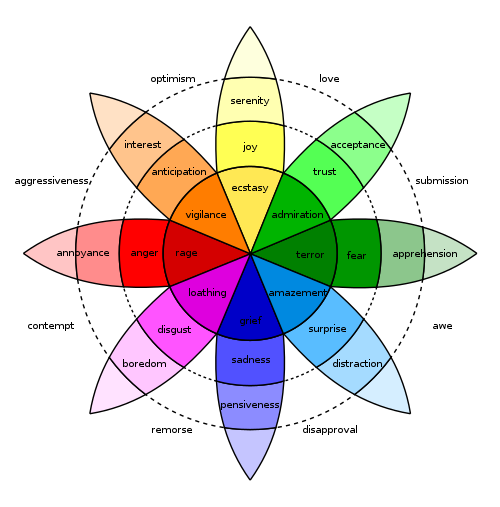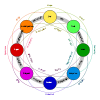Emotional dysregulation
Emotional dysregulation (ED) is a term used in the mental health community that refers to emotional responses that are poorly modulated and do not lie within the accepted range of emotive response.[1]
Emotional dysregulation can be associated with an experience of early psychological trauma, brain injury, or chronic maltreatment (such as child abuse, child neglect, or institutional neglect/abuse), and associated disorders such as reactive attachment disorder.[2] Emotional dysregulation may be present in people with psychiatric disorders such as attention deficit hyperactivity disorder,[3] autism spectrum disorders, bipolar disorder, borderline personality disorder, complex post-traumatic stress disorder, and fetal alcohol spectrum disorders.[4][5][6] In such cases as borderline personality disorder and complex post-traumatic stress disorder,[7] hypersensitivity to emotional stimuli causes a slower return to a normal emotional state. This is manifested biologically by deficits in the frontal cortices of the brain.[8]
Possible manifestations of emotional dysregulation include extreme tearfulness, angry outbursts or behavior outbursts such as destroying or throwing objects, aggression towards self or others, and threats to kill oneself. Emotional dysregulation can lead to behavioral problems and can interfere with a person's social interactions and relationships at home, in school, or at place of employment.
Etymology
The word "dysregulation" is a neologism created by combining the prefix "dys-" to "regulation". According to Webster's Dictionary, dys- has various roots and is of Greek origin. With Latin and Greek roots, it is akin to Old English tō-, te- "apart" and in Sanskrit dus- "bad, difficult."
Child psychopathology
There are links between child emotional dysregulation and later psychopathology.[9] For instance, ADHD symptoms are associated with problems with emotional regulation, motivation, and arousal.[10] One study found a connection between emotional dysregulation at 5 and 10 months, and parent-reported problems with anger and distress at 18 months.[11] Low levels of emotional regulation behaviors at 5 months were also related to non-compliant behaviors at 30 months.[12] While links have been found between emotional dysregulation and child psychopathology, the mechanisms behind how early emotional dysregulation and later psychopathology are related are not yet clear.
Symptoms
Smoking, self-harm, eating disorders, and addiction have all been associated with emotional dysregulation.[13] Somatoform disorders may be caused by a decreased ability to regulate and experience emotions or an inability to express emotions in a positive way.[14] Individuals who have difficulty regulating emotions are at risk for eating disorders and substance abuse as they use food or substances as a way to regulate their emotions.[15][16] Emotional dysregulation is also found in people who are at increased risk to develop a mental disorder, in particular an affective disorder such as depression or bipolar disorder.[17][18]
Early childhood
Research has shown that failures in emotional regulation may be related to the display of acting out, externalizing disorders, or behavior problems. When presented with challenging tasks, children who were found to have defects in emotional regulation (high-risk) spent less time attending to tasks and more time throwing tantrums or fretting than children without emotional regulation problems (low-risk). These high-risk children had difficulty with self-regulation and had difficulty complying with requests from caregivers and were more defiant.[19] Emotional dysregulation has also been associated with childhood social withdrawal.[20] Common signs of emotional dysregulation in early childhood include isolation, throwing things, screaming, lack of eye contact, refusing to speak, rocking, running away, crying, dissociating, high levels of anxiety, or inability to be flexible.
Internalizing behaviors
Emotional dysregulation in children can be associated with internalizing behaviors including[13]
- exhibiting emotions too intense for a situation
- difficulty calming down when upset
- difficulty decreasing negative emotions
- being less able to calm themselves
- difficulty understanding emotional experiences
- becoming avoidant or aggressive when dealing with negative emotions
- experiencing more negative emotions
Externalizing behaviors
Emotional dysregulation in children can be associated with externalizing behaviors including[13]
- exhibiting more extreme emotions
- difficulty identifying emotional cues
- difficulty recognizing their own emotions
- focusing on the negative
- difficulty controlling their attention
- being impulsive
- difficulty decreasing their negative emotions
- difficulty calming down when upset
Protective factors
Early experiences with caregivers can lead to differences in emotional regulation. The responsiveness of a caregiver to an infant's signals can help an infant regulate their emotional systems. Caregiver interaction styles that overwhelm a child or that are unpredictable may undermine emotional regulation development. Effective strategies involve working with a child to support developing self-control such as modeling a desired behavior rather than demanding it.[21]
The richness of environment that a child is exposed to helps development of emotional regulation. An environment must provide appropriate levels of freedom and constraint. The environment must allow opportunities for a child to practice self-regulation. An environment with opportunities to practice social skills without over-stimulation or excessive frustration helps a child develop self-regulation skills.[21]
Emotional dysregulation and substance use
Several variables have been explored to explain the connection between emotion dysregulation and substance use in young adults, such as child maltreatment, cortisol levels, family environment, and symptoms of depression and anxiety. Vilhena-Churchill and Goldstein (2014)[22] explored the association between childhood maltreatment and emotional dysregulation. More severe childhood maltreatment was found to be associated with an increase in difficulty regulating emotion, which in turn was associated with greater likelihood of coping by using marijuana. Kliewer et al. (2016)[23] performed a study on the relationship between negative family emotional climate, emotional dysregulation, blunted anticipatory cortisol, and substance use in adolescents. Increased negative family emotional climate was found to be associated with high levels of emotional dysregulation, which was then associated with increased substance use. Girls were seen to have blunted anticipatory cortisol levels, which was also associated with an increase in substance use. Childhood events and family climate with emotion dysregulation are both factors seen linked to substance use. Prosek, Giordano, Woehler, Price, and McCullough (2018)[24] explored the relationship between mental health and emotion regulation in collegiate illicit substance users. Illicit drug users reported higher levels of depression and anxiety symptoms. Emotional dysregulation was more prominent in illicit drug users in the sense that they had less clarity and were less aware of their emotions when the emotions were occurring.
Treatment
While Cognitive Behavioral Therapy is the most widely prescribed treatment for such psychiatric disorders, a commonly prescribed psychotherapeutic treatment for emotional dysregulation is Dialectical Behavioral Therapy, a psychotherapy which promotes the use of mindfulness, a concept called dialectics, and emphasizes the importance of validation and maintaining healthy behavioral habits.[25][26].
When diagnosed as being part of ADHD, norepinephrine and dopamine reuptake inhibitors such as methylphenidate (Ritalin)[27] and atomoxetine[28] are often used.
See also
- Attachment theory
- Blunted affect
- Borderline personality disorder
- Complex post-traumatic stress disorder
- Conduct disorder
- Emotional self-regulation
- Externalizing disorders
- Labile affect
- Oppositional defiant disorder
- Spiritual crisis
- The WAVE Trust
References
- Austin and Highnet, 2017
- Schechter DS, Willheim E (July 2009). "Disturbances of attachment and parental psychopathology in early childhood". Child and Adolescent Psychiatric Clinics of North America. 18 (3): 665–86. doi:10.1016/j.chc.2009.03.001. PMC 2690512. PMID 19486844.
- Retz, Wolfgang; Stieglitz, Rolf-Dieter; Corbisiero, Salvatore; Retz-Junginger, Petra; Rösler, Michael (9 January 2014). "Emotional dysregulation in adult ADHD: what is the empirical evidence?". Expert Review of Neurotherapeutics. 12 (10): 1241–1251. doi:10.1586/ern.12.109. PMID 23082740.
- Pynoos R, Steinberg A, Piacentini J (1999). "A developmental psychopathology model of childhood traumatic stress and intersection with anxiety disorders". Biological Psychiatry. 46 (11): 1542–1554. CiteSeerX 10.1.1.456.8902. doi:10.1016/s0006-3223(99)00262-0. PMID 10599482.
- Schore, A., (2003). Affect dysregulation and disorders of the self. New York: Norton.
- Bjorkquist, Olivia (2010). "Cingulate gyrus morphology in children and adolescents with fetal alcohol spectrum disorders". Psychiatry Research: Neuroimaging. 181 (2): 101–107. doi:10.1016/j.pscychresns.2009.10.004. PMC 2815126. PMID 20080394.
- Brewin CR, Cloitre M, Hyland P, Shevlin M, Maercker A, Bryant RA, Humayun A, Jones LM, Kagee A, Rousseau C, Somasundaram D, Suzuki Y, Wessely S, van Ommeren M, Reed GM (December 2017). "A review of current evidence regarding the ICD-11 proposals for diagnosing PTSD and complex PTSD" (PDF). Clinical Psychology Review. 58: 1–15. doi:10.1016/j.cpr.2017.09.001. PMID 29029837.
- Clinical trial number NCT00467038 for "Treatment of Aggression, Anger and Emotional Dysregulation in Borderline Personality Disorder" at ClinicalTrials.gov
- De Caluwé E, Decuyper M, De Clercq B (July 2013). "The child behavior checklist dysregulation profile predicts adolescent DSM-5 pathological personality traits 4 years later". European Child & Adolescent Psychiatry. 22 (7): 401–11. doi:10.1007/s00787-013-0379-9. PMID 23381573.
- Barkley RA (January 1997). "Behavioral inhibition, sustained attention, and executive functions: constructing a unifying theory of ADHD". Psychological Bulletin. 121 (1): 65–94. doi:10.1037/0033-2909.121.1.65. PMID 9000892.
- Stifter CA, Jain A (1996). "Psychophysiological correlates of infant temperament: Stability of behavior and autonomic patterning from 5 to 18 months". Developmental Psychobiology. 29 (4): 379–391. CiteSeerX 10.1.1.590.8991. doi:10.1002/(sici)1098-2302(199605)29:4<379::aid-dev5>3.0.co;2-n. PMID 8732809.
- Stifter CA, Spinrad TL, Braungart-Rieker JM (1999). "Toward a developmental model of child compliance: the role of emotion regulation in infancy". Child Development. 70 (1): 21–32. doi:10.1111/1467-8624.00003. PMID 10191513.
- Macklem, G.L. (2008). Practitioner's Guide to Emotion regulation in School – Aged Children. NY: Springer.
- Waller E, Scheidt CE (February 2006). "Somatoform disorders as disorders of affect regulation: a development perspective". International Review of Psychiatry. 18 (1): 13–24. doi:10.1080/09540260500466774. PMID 16451876.
- Sim L, Zeman J (2006). "The contribution of emotion regulation to body dissatisfaction and disordered eating in early adolescent girls". Journal of Youth and Adolescence. 35 (2): 207–216. doi:10.1007/s10964-005-9003-8.
- Tice DM, Bratslavsky E, Baumeister RF (January 2001). "Emotional distress regulation takes precedence over impulse control: if you feel bad, do it!". Journal of Personality and Social Psychology. 80 (1): 53–67. doi:10.1037/0022-3514.80.1.53. PMID 11195891.
- Kanske P, Schönfelder S, Forneck J, Wessa M (January 2015). "Impaired regulation of emotion: neural correlates of reappraisal and distraction in bipolar disorder and unaffected relatives". Translational Psychiatry. 5: e497. doi:10.1038/tp.2014.137. PMC 4312831. PMID 25603413.
- Heissler J, Kanske P, Schönfelder S, Wessa M (January 2014). "Inefficiency of emotion regulation as vulnerability marker for bipolar disorder: evidence from healthy individuals with hypomanic personality". Journal of Affective Disorders. 152-154: 83–90. doi:10.1016/j.jad.2013.05.001. PMID 23948633.
- Calkins SD, Dedmon SE (April 2000). "Physiological and behavioral regulation in two-year-old children with aggressive/destructive behavior problems". Journal of Abnormal Child Psychology. 28 (2): 103–18. doi:10.1023/A:1005112912906. PMID 10834764.
- Garcia-Coll C, Kagan J, Reznick J (1984). "Behavioral inhibition in young children". Child Development. 55: 505–529.
- Bronson M. B. (2000). Self-regulation in early childhood. New York: Guilford Press.
- Vilhena-Churchill N, Goldstein AL (May 2014). "Child maltreatment and marijuana problems in young adults: examining the role of motives and emotion dysregulation". Child Abuse & Neglect. 38 (5): 962–72. doi:10.1016/j.chiabu.2013.10.009. PMID 24268374.
- Kliewer W, Riley T, Zaharakis N, Borre A, Drazdowski TK, Jäggi L (September 2016). "Emotion dysregulation, anticipatory cortisol, and substance use in urban adolescents". Personality and Individual Differences. 99: 200–205. doi:10.1016/j.paid.2016.05.011. PMC 5082236. PMID 27795602.
- Prosek EA, Giordano AL, Woehler ES, Price E, McCullough R (September 2018). "Differences in Emotion Dysregulation and Symptoms of Depression and Anxiety among Illicit Substance Users and Nonusers". Substance Use & Misuse. 53 (11): 1915–1918. doi:10.1080/10826084.2018.1436563. PMID 29465278.
- "Borderline personality disorder - Diagnosis and treatment - Mayo Clinic".
- "Emotion Dysregulation Treatment with DBT".
- Suzer Gamli, Ipek; Tahiroglu, Aysegul (2018). "Six months methylphenidate treatment improves emotion dysregulation in adolescents with attention deficit/Hyperactivity disorder: A prospective study". Neuropsychiatric Disease and Treatment. 14: 1329–1337. doi:10.2147/NDT.S164807. PMC 5973442. PMID 29872300.
- Reimherr, Frederick W.; Marchant, Barrie K.; Strong, Robert E.; Hedges, Dawson W.; Adler, Lenard; Spencer, Thomas J.; West, Scott A.; Soni, Poonam (July 2005). "Emotional Dysregulation in Adult ADHD and Response to Atomoxetine". Biological Psychiatry. 58 (2): 125–131. doi:10.1016/j.biopsych.2005.04.040. PMID 16038683.

